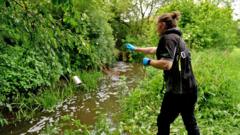Has Los Angeles Finally Escaped the Worst Traffic Ranking in the U.S.?

Washington DC: The New Capital of Traffic Congestion
In a surprising turn of events, Washington DC has overtaken Los Angeles as the US city with the worst traffic, according to annual rankings by Consumer Affairs. This change reflects a broader trend in urban mobility and the impact of economic factors on commuting patterns. Drivers in the nation’s capital now spend an average of 33.4 minutes in traffic each day, surpassing all other major metropolitan areas in the United States. This article explores the reasons behind this significant shift, the implications of traffic congestion on urban living, and what it means for commuters in Washington DC.
The Statistics Behind the Shift
According to the latest traffic data from Consumer Affairs, the average length of weekday congestion in Washington DC is a staggering six hours and 35 minutes. This is only marginally lower than Los Angeles, which still holds the highest daily congestion levels. However, despite its notorious traffic jams, Los Angeles boasts an average commute time of just over 30 minutes. This indicates a complex relationship between traffic congestion and commuting efficiency, as both cities struggle with significant delays.
To put this into perspective, the average commuter in Washington DC spends approximately 71 days a year stuck in traffic. This is a considerable amount of time that could be spent on more productive activities, raising questions about the quality of life in such congested urban environments. With Miami, San Francisco, and Atlanta rounding out the top five cities with the worst traffic, it is evident that urban congestion is a growing concern across several major cities in the United States.
Economic Factors and Traffic Congestion
Interestingly, the cities with the worst traffic congestion also tend to be those with the highest economic output. This phenomenon is not mere coincidence; as urban planning expert Michael Manville from the UCLA Luskin School of Public Affairs notes, a growing economy attracts new residents while retaining existing ones. Many of these residents rely on personal vehicles for their daily commutes, leading to increased traffic congestion.
In essence, congestion can often be viewed as a sign of economic prosperity. As cities grow and evolve, they attract businesses, create jobs, and encourage more people to move in. This influx contributes to a higher demand for road space, which can lead to significant traffic delays, especially during rush hours.
The Impact of Remote Work Policies
The shift in traffic rankings has also been influenced by recent policy changes regarding remote work. Following President Donald Trump’s directive for federal workers to return to their offices, Washington DC saw an increase in the number of commuters on the roads. This return to office life has exacerbated congestion issues, as many workers are now commuting during peak hours once again.
While public transportation usage in the region has increased compared to the pandemic, it still lags behind pre-2019 levels. This indicates that many commuters are still opting for personal vehicles instead of public transit options, which further contributes to the traffic woes in the city.
Real-Life Experiences of Commuters
Local commuters have expressed their frustrations with the growing traffic congestion. Jonathan Roush, a commuter in the region, remarked on a radio station that the traffic in DC "stinks." His proactive approach involves scheduling work hours to avoid peak traffic times, a strategy many others have adopted to cope with the congestion. This anecdote highlights the daily challenges faced by residents as they navigate their commutes in an increasingly congested city.
Contrasting Cities with Less Traffic
Interestingly, the cities ranked with the least traffic congestion include Rochester, Salt Lake City, and Cleveland. These urban areas, once prominent centers of industry, have experienced a decline in their industrial base, leading to more available road space and less congestion. This contrast raises questions about urban planning and the sustainability of traffic management strategies in cities experiencing growth versus those in decline.
What Lies Ahead for Washington DC?
As Washington DC continues to grapple with its new status as the city with the worst traffic, urban planners and policymakers will need to address the underlying issues contributing to congestion. Solutions may include enhancing public transportation systems, developing infrastructure to accommodate a growing population, and encouraging carpooling or remote work options to alleviate pressure on the roads.
In addition, investment in smart city technologies that optimize traffic flow and provide real-time data to commuters could be beneficial. These solutions aim to create a more efficient urban environment while supporting continued economic growth.
Potential Solutions to Combat Traffic Congestion
To tackle the issue of traffic congestion effectively, cities like Washington DC can explore several potential solutions:
- Enhanced Public Transportation: Improving the reliability, coverage, and affordability of public transit systems can encourage more commuters to use buses and trains.
- Carpooling Initiatives: Promoting carpooling through incentives or dedicated carpool lanes can reduce the number of vehicles on the road.
- Flexible Work Arrangements: Encouraging companies to adopt flexible work hours or hybrid work models can help spread out commuting times.
- Smart Traffic Management: Implementing technology-driven solutions, such as adaptive traffic signals and real-time traffic updates, can improve traffic flow.
- Infrastructure Development: Investing in road expansions and alternative routes can alleviate bottlenecks in high-traffic areas.
FAQs
What are the main causes of traffic congestion in Washington DC?
Traffic congestion in Washington DC is primarily caused by a growing population, increased economic activity, and a rise in commuter traffic due to remote work policies being reversed. The reliance on personal vehicles, coupled with insufficient public transportation options, further exacerbates the problem.
How does traffic congestion impact the economy?
Traffic congestion can have significant economic implications, including lost productivity, increased fuel costs, and higher transportation expenses for businesses. These factors can hinder economic growth and deter new investments in urban areas.
What cities have the least amount of traffic congestion?
Cities such as Rochester, Salt Lake City, and Cleveland are known for having the least traffic congestion. These cities have seen a decline in industrial activity, resulting in lower traffic volumes and more available road space.
What measures can be taken to reduce traffic congestion?
Measures to reduce traffic congestion include enhancing public transportation, promoting carpooling, implementing flexible work arrangements, utilizing smart traffic management technologies, and investing in infrastructure improvements.
Will traffic congestion continue to worsen in Washington DC?
Unless proactive measures are taken to address the underlying causes of traffic congestion, it is likely that conditions will worsen, especially with a growing population and economic activity in the region.
As Washington DC grapples with its new position as the city with the worst traffic in the United States, it faces a significant challenge that requires immediate attention and strategic planning. The interplay between economic growth and traffic congestion presents both opportunities and obstacles for city planners and residents alike. How will the city adapt to its new reality, and what changes will be made to improve the commuting experience for its residents? #WashingtonTraffic #UrbanPlanning #CommutingChallenges
Published: 2025-07-23 19:28:02 | Category: wales



